The Cosmic Dancer:
Sculpture and the Absence of Gravity
Arthur Woods
*
Espiweg 38, CH-8240 Stein am Rhein, Switzerland.
Abstract
As human civilization is extended beyond the planet, its culture will be altered by the conditions of the new environment. This article examines the development of sculpture as a terrestrial art form and the ways in which its creation and perception have been influenced by the "gravity constant." The author discusses the evolution of his Cosmic Dancer sculpture series, from an exploration of multiple resting points on Earth to the infinite perceptual possibilities attainable in the space environment.
THE ART OF SCULPTURE
The Expression of an Ideal in Plastic Form
In addition to language or speech, art has been a fundamental way of communicating humankind's understanding of the universe. In the book The Meaning of Art , British art historian Herbert Read discusses the evolution of our understanding and appreciation of art. "Art," Read says, "is the expression of any ideal that the artist can realize in plastic form" [1]. And while the "expressive" aspects of art are subjective and temporal - aesthetic values vary from person to person, culture to culture and among different periods of civilization - form, though intuitive in origin, is more universal and can be analyzed in intellectual terms, such as measure, balance, rhythm and harmony.
Since the early days of Greek philosophy, there has been an attempt to find in art a geometrical law of proportions. The discovery of the Golden Section is one example of the human search for a key to the mysteries of art. The composition of any artwork must adhere to some physical principle so that the artwork does not distract the eye by its "unease" or lack of balance. The artist proceeds intellectually or instinctively, by mathematical formulae or by intuition, and usually ends up using a mixture of approaches.
In a good work of art, all of its elements are interrelated for a coherent unity - content and form fused into its overall message or meaning. Such images, exploiting the expressive qualities of form, go beyond mere representation of fact and can communicate a wide range of subtle and powerful feelings.
The Preeminence of the Arts
The preeminence of the arts was a frequent topic of discussion in the sixteenth century, particularly in relation to the status of painting versus sculpture. Sculptors, such as Benvenuto Cellini, thought that sculpture was eight times as great as painting because sculpture had eight views that all must be equally convincing. In the sculptors' view, painting, as a representation of just one point of view, was like a shadow compared to the object casting it. Painters, such as Leonardo da Vinci, on the other hand, thought painting to be superior and more intellectual than sculpture because, as a technique, it is infinitely more subtle in the effects it can produce and infinitely broader in its capacity to provoke invention or imagination.
Michelangelo pointed out that there were "true" and "false" forms of sculpture. True sculpture is the sort that is created by cutting away from the block. The other sort is executed by building up, or "modeling," and thus resembles painting. After his time, the modeling approach became predominant, although modeled works were then often translated by various means into stone or cast into bronze to make them durable [2].
Until the beginning of the 20th century, sculpture usually had some direct relationship to the world in which it was created. Whether it was the human form as subject or some other aspect of nature, the sculptor's intent was to render the subject in a convincing, representational manner in three dimensions. Even primitive sculpture, in its symbolic or mystical approach, related to some area of natural phenomena. Sculpture was essentially an art of solid form or mass. The negative aspects of sculpture, i the voids and hollows, while always an intricate part of the design, played a secondary role.
Sculpture in the Twentieth Century
With this century, a new approach to sculpture developed from the movement called constructivism. Originating in Russia before the revolution, constructivism was inspired by the desire to renounce all associations with natural phenomena and to create an art of pure or absolute form. Constructivist artists used plane, volume, mass and space to create a dynamic unity or tension within abstract sculptural forms. With constructivism, a concern for the spatial aspects of sculpture developed and has now become dominant.
Other modern approaches to sculpture have explored aspects of nature via symbolic form or have been guided by the material of the sculpture itself without renouncing natural phenomena. These modern types of sculpture appeal to the intellect and exist on their own terms in relationship to the environment. Today, there is also a new form called "conceptual" sculpture. This approach to sculpture may have abandoned the premise that a sculpture is indeed a tangible object at all, as these "idea" works often cannot be classified as physical, three-dimensional (3D) objects in the traditional sense.
THE PRINCIPALS AND QUALITIES OF SCULPTURE
Sculpture as a 3D Object
It can be stated generally that sculpture is not merely a replication of form and feature but, rather, the translation of meaning from one material into another material. Regardless of whether it portrays a natural phenomenon or is an abstract construction, any sculpture that can be defined as an artistic object existing in the environment and occupying a 3D space shares certain fundamental qualities - the most important being mass and space. These in turn determine the qualities of plane and volume.
While mass is the material substance of a sculpture, space enters its design in three ways: the components of the sculpture may (1) extend or move through space, (2) enclose or enfold space within the sculpture and/or (3) relate across space one to another.
As sculpture is both visual and tactile, the surface qualities of colour, material and texture are also essential. It is the surface of the sculpture that one actually sees. It defines the internal structure of the mass of the sculpture and is the part of the sculpture that relates to the environment or space in which it exists.
Specific environmental settings may in turn influence the perception of sculpture. Throughout history, many sculptures were commissioned and/or conceived for specific settings, such as churches, tombs or public buildings. Ornamental or symbolic value became implicit in the purpose of these surroundings. The scale of the sculpture, or its size in relation to its subject or in relation to its surroundings, is often a part of its content.
The whole of a 3D form cannot be seen in its totality at once. Yet it is possible to apprehend solid forms as volumes and to understand something of them from any one perspective. Usually, one walks around or turns the object to complete one's evaluation or perception of it [3].
The Gravity Constant
Another environmental factor, one that has hardly been considered yet, that influences and determines both the conception and the perception of sculpture, is the "gravity constant." Because they are created in a terrestrial civilization, all sculptures have a "resting point" - a point of contact at which their mass interacts with the gravity of the Earth. Sometimes sculptures are fixed to a base so that their appearance seems natural in our gravity-dominated environment. Others stand, rest or are fixed on some supporting structure. Even "balloon," or air-filled, sculptures that may float in the air are positioned by the forces of gravity.
Consciously or unconsciously, artists conceive and carry out their sculptural creations with the gravity constant determining the eventual resting point of the work, and, by so doing, they predetermine how the sculpture eventually will be perceived and appreciated by the public. This gravity constant has much to do with our perception and appreciation of sculpture - as our response to its aesthetic "rightness" is based on our own experiences in our terrestrial environment.
In the zero-gravity (zero-G) environment of outer space, the gravity constant disappears - sculptures become weightless. As a consequence, the conception, perception and appreciation of an artwork will be altered in such an environment.
MY SCULPTURE
Sculpture as 3D Painting: 1978-1985
Since 1977 all of my art has had a "cosmic" content. Not only my subject matter but also my artistic technique has been influenced by contemporary scientific understandings of the subatomic universe. The nature of all the material of the universe is dynamic - full of eneregy and motion. To express this quality in my art, I have used points of colour as metaphors for atoms or particles, calligraphic lines as indicators of energy and motion, and geometric lines or forms as reference points or guides to understanding the work.
My approach to 3D art began within my painting. The Voyager works of 1978-1982 illustrate my interest in projecting a quality of 3D illusion onto a two-dimensional surface. (Fig. 1). I decided to blend the concepts of painting and sculpture, so I began to apply my painting technique to actual 3D objects. The first of these were paintings on stone, bricks and other found objects.

Fig 1. Voyager, one in a series, acrylic on shaped canvas, 120 x 150 cm, 1995. This series of paintings approached three-dimensional illusion on a two-dimensional surface.
The Cosmic Dancers Sculpture Series
In 1981 I began to construct my own sculptural forms - twisted geometric shapes made mostly of wood and steel (Fig. 2). I also painted these forms with spots and calligraphic lines. My rationale for applying my painting technique to the sculptures was three-fold: (1) I wanted to translate my expression of the microcosmos onto a tangible form, (2) I wanted to make 3D paintings and (3) I wanted to disguise the material or remove its quality from the overall perception of the sculpture.
This resulted in a series of sculptures that I have executed since 1981 called the Cosmic Dancers. This title was inspired by the description of the universe found in both modern physics and Eastern religions - a cosmos made up of a dynamic flow of energy and matter [4]. The geometric constructions of these sculptures caused them to have multiple resting points. This allowed the sculptures to be turned and poised in different positions, which in effect makes each of them appear, when viewed from a variety of angles, to be a variety of sculptures (Fig. 3). Although each sculpture has a unique form, the painting on the sculptures serves as a means to identify each one in all of its various resting positions. Depending on the complexity of the sculpture, usually four to eight different resting positions can be found for each sculpture - the gravity constant is the final determining factor.
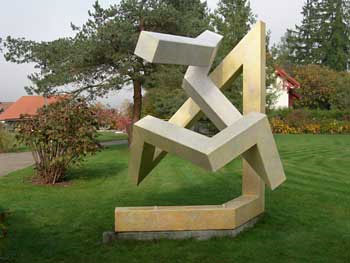
Fig 2. Cosmic Dancer , one in a series, acrylic on steel, 3 meters in height, 1985. This sculpture is installed outdoors in the Specogna Complex, Glattfelden, Switzerland.
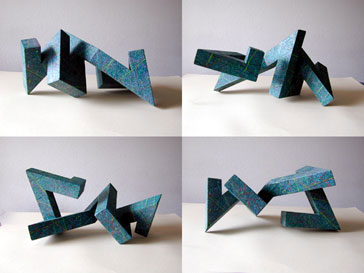
Fig. 3. Reclining Dancer, acrylic on woods, 25 x 35 x 66, 1993. Each of these pictures features the same sculpture balanced on a different set of resting points.
The OURS Space Sculptures
In 1984 I began to consider creating orbiting artworks in the outer space environment, specifically in Low Earth Orbit (LEO). Having grown up in the vicinity of the Kennedy Space Center in Florida, I felt it was natural that art would accompany all the other activities into this new environment as civilization was extended beyond the atmosphere of our home planet. In 1985, I initiated the Orbiting Unification Ring Satellite (O.U.R.S.) project [5]. To be realized in the year 2000, this orbiting sculpture, with a diameter of about 1 km, is designed to be visible as a "circle in the sky" to the entire world population. In 1988, I initiated the OUR-Space Peace Sculpture (OUR-SPS) project (Fig. 4) [6]. This sculpture, 6 meters in diameter and in the form of the astronomical symbol of the Earth, was designed to be deployed from the Mir space station in 1992. An essential ingredient of the deployment scenario was my plan for a cosmonaut to deploy this "weightless sculpture" by hand during a spacewalk. Had this occurred, a second cosmonaut would have made a video record of the deployment. The project was accepted by Soviet space officials and a full-scale inflatable test model of the sculpture was manufactured by NPO Energia of Moscow in 1990 with a launch foreseen in April 1992 (Fig. 5). Due to the uncertainties associated with the dissolution of the former Soviet Union, sponsor support failed to concretize at the critical funding moment, and the project was canceled.
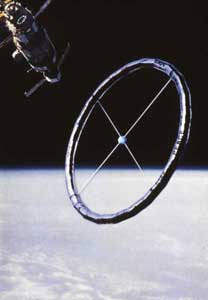
Fig. 4. Artist's conception the OUR-Space Peace Sculpture, as it would look in space deployed from the Mir space station.
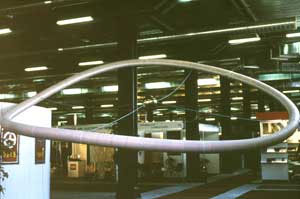
Fig. 5. Full size inflated model of the OUR-Space Peace Sculpture built by NPO Energia, 1990.
THE COSMIC DANCERS IN SPACE
In the Absence of Gravity
In the time I have spent contemplating the logistics of realizing such artworks in space, I have often reflected and visualized how such artworks would appear in a weightless environment. Whereas the OURS sculptures were designed around universal symbolic forms, their positioning was not a major factor in their perception. First, their positions could be determined or controlled technologically to maximize their appearance for the terrestrial audience, and, second, the use of universal symbolic shapes would make it possible for people to complete their perception of the sculptures in their mind, regardless of the actual position of the sculpture when it was viewed. From the Earth, the OURS for the year 2000 would appear as a circle, an ellipse or a line in the sky, depending on one's proximity to the orbital path of the sculpture. The perception of the OUR-SPS would be determined largely by the expertise and involvement of the cosmonaut doing the filming.
Infinite Perspectives
The OURS sculptures, though utilizing the space environment for their realization, are essentially terrestrial artworks, in the sense that their targeted public remains on Earth.
When imagining human civilization extended into outer space, I think it is obvious that the art of this civilization will take advantage of its new environment. The qualities specific to this environment will have a fundamental effect on both the conception and perception of the artworks in it - much like the "gravity constant" has had on the evolution of terrestrial art. A sculpture floating in a zero-G environment could be viewed from an infinite number of perspectives or angles.
The Cosmic Dancers in the Space Environment
I decided to further develop the Cosmic Dancer series by introducing these works to the weightless environment of outer space. When this occurs, they will be viewed from an infinite number of perspectives made possible by the outer space environment. This activity will also answer the following questions:
1. How will human beings in weightless environments react to or be affected by such artworks co-existing in the same environment?
2. How will a free-floating sculpture react within a pressurized and weightless environment, especially in terms of the effects of spacecraft movement and airflow?
3. What are the positioning characteristics of a sculpture in the open environment of outer space? Specifically, where does the gravity constant cease to have a perceptible effect on the positioning of the sculpture?
4. How will the contribution of such cultural objects be evaluated in the context of other human activities in the environment of outer space?
A Small-Scale and a Large-Scale Experiment
For these aspects to be realistically evaluated, the Cosmic Dancers must be physically introduced into the outer space environment. Therefore, I have conceived a two-stage plan consisting of (1) a small-scale experiment that will utilize a pressurized and human-occupied environment and (2) a large-scale experiment that would be realized in an open outer space environment.
Small-Scale Weightless Cosmic Dancer Experiment.
The small-scale experiment will consist of a small Cosmic Dancer weighing about 1 kg and measuring approximately 35 x 35 x 40 cm. The sculpture will be constructed of welded, hollow aluminum tubing for lightness and stability. This sculpture can be easily packaged and sent into space for evaluation in a human-occupied environment such as the U.S. space shuttle or the Russian Mir space station (Fig.6).
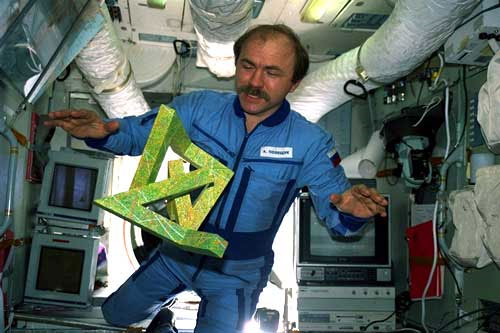
Fig. 6. Cosmonaut Alexander Polischuk and the Cosmic Dancer sculpture in the Mir space station. Note: Photo taken after this paper was written.
There are no foreseen technical or safety issues connected to this approach. The concept will allow the sculpture to be released and to "float" in the crew environment. The crew will evaluate their reactions to the sculpture sharing their space and make a video recording of it.
This experiment can be conducted for approximately $150,000, depending on the amount of time the crew would be involved in the experiment. The financing of my proposal will come from the sale of a limited edition of replica sculptures and related artworks, such as project drawings and photographs. Figure 6 illustrates the weightless characteristics of the Cosmic Dancer in the outer space environment.
Even though the National Aeronautics and Space Administration (NASA) does not encourage cultural experiments of this nature, I nevertheless approached the agency. I was informed that, although the Cosmic Dancer project had merit, there is no current program to launch "non-scientific payloads" on the space shuttle [7]. As the Russians are seeking various kinds of commercial projects to maintain their space program, I also approached them. A contract to launch a Cosmic Dancer sculpture to the Mir space station in the spring of 1993 was signed with Kayser-Threde GmbH of Munich, representing NPO Energia [8].
Large-Scale Free-Flight Cosmic Dancer Experiment.
Once the small-scale experiment has been successfully conducted, the large-scale experiment, which is more complex both in the technical aspects and in its realization prospects, will follow. The large-scale Cosmic Dancer sculpture will be constructed out of reflective inflatable materials, such as Mylar, Kapton or Kevlar, and will be deployed directly into the space environment. The sculpture will weigh less than 4 kg yet will measure up to 30 meters in its largest dimension. Deployed in LEO from the space shuttle or from the Mir space station, its appearance in the space environment would also be recorded on videotape.
A sculpture of these dimensions would be visible to people on the planet as a blinking star while the Cosmic Dancer orbits the planet. At the orbital altitudes associated with the above spacecraft, the Cosmic Dancer would de-orbit in a matter of days. It would also be possible to launch the Cosmic Dancer on an expendable launcher into a higher orbit, where it would remain for a longer period of time.
The costs of constructing and space-qualifying such a sculpture by an aerospace firm are estimated to be approximately $2-5 million. Deployment from the U.S. space shuttle could cost approximately $1 million, if their Complex Autonomous Payload (CAP) program were utilized [9]. The cost of deployment from the Mir space station is considered to be less. A piggy-back launch and deployment from the Ariane launcher is estimated to cost $250,000 [10].
The feasibility of the project rests with the ability to have it financed. Like the small-scale experiment, this would be done initially through the sale of project-related artworks and, due to the higher costs, sponsorship will be sought.
The main obstacle, however, is the need to develop the necessary interest, cooperation and support from the launching agencies. Without this cooperation, it would be difficult to realize such an artwork in the space environment even if the funding were available. The small-scale experiment creates a precedent for such cooperation, which hopefully will lead to the realization of the large-scale experiment and/or to similar art-in-space projects.
CONCLUSIONS
The Cosmic Dancer program for space has been launched. As mentioned above, it is possible to fly the small-scale experiment in a very short time under the present circumstances in the Russian space program, and a program is underway to do so in the spring of 1993. Conceivably, the large-scale experiment could be realized by 1996 if associated with some other large manifestation or as a part of the OURS development program.
As human civilization is extended beyond the planet, its culture will be altered by the environment. Since art and society are interdependent, art will play an important role in sensitizing human society to new environments in outer space.
It has been shown that environmental characteristics such as the gravity constant have played a subtle yet important role in the development of our art and culture. Thus, we can expect the art of sculpture to take on new dimensions as it is created for the outer-space environment, in which the gravity constant is not a factor. The Cosmic Dancer sculptures are designed to add to the cultural dimension of outer space development and to help bridge the terrestrial and extraterrestrial environments of human civilization.
References and Notes
1. Herbert Read, The Meaning of Art (London: Faber & Faber, 1931, 1974).
2. Read [1] pp. 244-246.
3. Leonard R. Rogers, "The Art of Sculpture," Encyclopedia Britannica, Vol. S (1986) pp. 40-56.
4. Fritjof Capra, The Tao of Physics (Boulder, CO: Shambhala, 1975) pp. 226-245.'
5. Arthur R. Woods, "OURS -The Orbiting Unification Ring Satellite," in The Spirit of Enterprise—The Book about the Rolex Awards (U.K.: Van Nostrand Reinhold, 1987) pp. 184-186.
6. Arthur R. Woods and Marco C. Bernasconi, "The OUR-Space Peace Sculpture: Further Developments in a Global Artwork for Space," Leonardo 24, No. 5, 601-606(1991).
7. Letter to author from Robert Schulmann, director of NASA's Art Program, 28 September 1992.
8. In December 1992, a contract for the realization of the small-scale experiment was signed with Kayser-Threde GmbH of Munich, Germany, representing NPO Energia of Moscow.
9. This information was communicated in a private conversation concerning the Get Away Special Program with Gary DuBro, Chief, Policy Development and Coordination Branch, Policy and Plans Division, Office of Space Flight, NASA.
10. Arianespace has set a price of $600,000 for a circular platform that would provide a launch opportunity for a maximum of six satellites as secondary payloads on an Ariane launcher.
* This paper was first presented as Paper ESW ‘92/25 at The First European Spare Art Workshop. Montreux, Switzerland, 21-27 March, 1992
** Published also in Leonardo, Vol. 26, No. 4, pp.297-301,1993
***New images added to paper in 2005. Published online.

